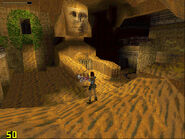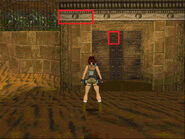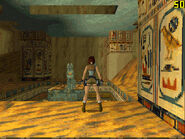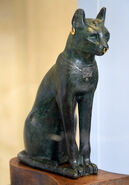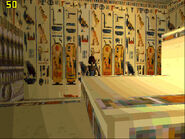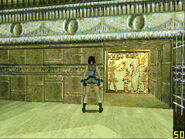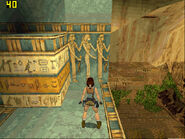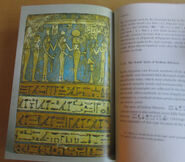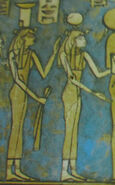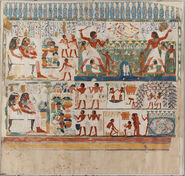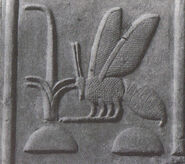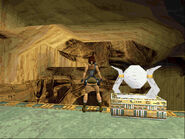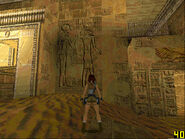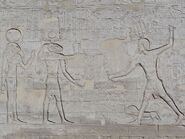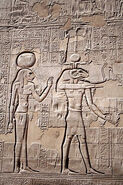Lara travels to Egypt by motorcycle. There she finds the once-lost city of Khamoon, filled with Egyptian art such as a sphinx, a temple, crocodiles, and walking mummies that explode.
Lara solves various puzzles and ventures into even older temples.
Known references[]
10.00 - The name "Khamoon"[]
The name of Khamoon is an Easter egg!
Read more here: Easter Egg page
10.01 - Sphinx and running mummy[]
The sphinx in the game is based on the Great Sphinx of Giza. It appears as if the sphinx is laughing. In Ancient Egypt, sphinxes were called "Shesep Ankh" or "Living Image." The sphinx was associated with the god Hor-em-Akhet or Horus of the Horizon.
10.02 - Entrance of a temple[]
Near the Sphinx is an entrance to a temple with reliefs. On them, there is a sun with wings (second image), which can also be found on pylons. It is a form of the god Horus, known as 'Horus Behedy' or 'Horus of Behedet.' Behedet is now known as Edfu.
10.03 - Cartouches near the temple of the cat[]
Lara Croft is looking at a pillar with colored hieroglyphs. At the top, there are three cartouches, or king's names. Then there is a text from left to right. After that is the king's name of Seti I, and then another king's name.
These colored hieroglyphs are based on an image made by Henry William Beechy, who copied a scene in the tomb of Seti I in the Valley of the Kings (tomb KV17), which was once discovered by Belzoni. Only the king's name of Seti I is real. The signs of the other king's names are copied and randomly put together. The row of hieroglyphs tells something about the goddess Nekhbet and a blessing to the pharaoh.[1]
10.04 - Statue of cat[]
The cat is a representative of the goddess Bastet . It has a Eye of Horus and a winged scarab on her belly. It is a remake of the Gayer-Anderson Cat statue now on the British museum named after major Gayer-Anderson. Egypt, Late Period, 600 BCE. Picture from here.[2] .
10.05 - More hieroglyphs[]
These colorful hieroglyphics came from a painting from Henry Williams Beechey as previously explained. These hieroglyphics make more sense. Some I can read:
- (in red): Nesut (king), Neb-tawy (king of the two lands = Egypt) Men-Maät-Re (throne name of Seti).
- (in blue): Neb-Khaw, Seti-meri-en-Ptah (Seti, beloved of Ptah)
- (in purple): something with the city of Ipet-sut (Karnak)
- (in green): Sa-Imen (son of Amun) Mesen-in-Mut-Nebet (born by the Mut), goddess of Isher. Mut = the wife of Amun, Isher is probably a temple somewhere in Karnak/Luxor where she was venerated as goddess. Maybe Seti saw himself as the god Khonsu . It’s not the first time the pharaoh saw him as equal as a god, his son Rameses II depicted himself as a god in the Abu Simbel temple. And Amenhetep III saw himself as the dazzling sun god (the Aten) at the end of his reign.
10.07 - Pharaoh performs an offer to a god[]
This is a golden plague of the Middle kingdom (2055-1650 BC) in the reign of Amenemhat IV . The good god Maä-Kheru-Re offers nice things to the god Atum of Iunu [1].
Amenemhat IV was the last male king of 12th dynasty of Ancient Egypt. After him reigned the first and last female king, Queen Sebekneferu (Sobek is beautiful). After her reign the 12th dynasty was over, the 13th was beginning. What fact is that the rulers of the 13th dynasty were not as powerful as the 12th dynasty. Most of the pharaohs ruled a short time from at least a few months to some years. I find it one of the most interesting period of Ancient Egypt.
10.08 - Gods with hieroglyphics[]
This one is kind of special. I could not find it on the internet, despite my tries. The scenery is from a tomb stela of Tashep-Khonsu, a female of the middle class in the Late Period.
It is now in the Egyptian Museum, Berlin . Accession number 932. I found it in the book Discovering Egyptian Hieroglyphs, A Practical Guide by Karl-Theodor Zauzich, published in 1992. ===
If I look closely, the two woman are Nephthys(Lady of the House) and Hathor (House of Horus).
10.09 - Person speak for the gods[]
This scenery came from an papyrus. It is called the the Book of the Dead from Hunefer , a few sheets of papyrus with drawings on it. It lies in the British Museums (inventory number EA 9901). Hunefer was a scribe during the 19th dynasty in the New Kingdom of Ancient Egypt.
Hunefer raises his arms to a college of gods. He will speak words as I didn’t do that or this. The gods are Ra (sun god), Atum (creator god), Shu (dry wind) and Tefnut (wet wind).
The book of the dead is a collection of papyrus of the New Kingdom. The dead one has to perform several spells to enter the Iaru fields. And of course the dead one reaches the fields in the afterlife and growing crops and be happy. Just like that.
10.10 - woman in papyrus fields[]
The scenery with the woman in the field of papyrus and the colour glass in Egyptian came from a scene of the Tomb of Nakht . The tomb lies in Sheikh Abd el-Qurna and has the code ===TT52=== (TT stands for Theban Tomb) and was build in the 18th dynasty.
It was copied by Norman de Garis Davies in 1915. The scene is now at the Metropolian Museum of Art in New York and it is called: Nakht and Family Fishing and Fowling. Image came from here
Core Design altered the image and deleted the man who hunts with the stick. But the kept the Egyptian style colours.
10.11 - Bee[]
The bee is part of the title of kings: Nesut-Bity or “he of the sedge and bee”. The sedge (plant symbol) is symbol for Upper-Egypt and the bee symbol for Lower-Egypt. I am not going to search for it because there are numerous depiction of a bee in hieroglyphs.
The picture for “bee” depicts bee but also honey. The Nile delta had a tradition for beekeeping. The center of this idea could be the Temple of Neith in Saïs . Her temple was also called: Castle of the bee” (source Maria Camela Betrò, ‘Hiërogliefen, de beeldtaal van het oude Egypte’, page 117)
10.12 - Hathor symbol on a sarcophagus[]
The white sun disc and cow horns is the symbol of the goddess Hathor . Here is a depiction of her on a statue of Mycerinos (Menkaura) (4th dynasty).
That thing under the sun disc and cow horns is a coffin. It’s the coffin of Khnumhotep . There are three people with the name of Khnumhotep, I don’t know witch one it is. But it is currently in the Metropolian Museum of Art in New York.
10.13 - some statues of pharaohs[]
I think that the statues came from the British museum (room nr. 4) or from a book about ancient Egypt. The text right from the most right statue doesn’t ring me a bell.
10.14 - Two gods.[]
The relief can be found on the walls of the Esna Temple . Esna was called Latopolis and was the domain of the gods Khnum , Menhit, Nebtu, Heka and Neith .
In this scene the pharaoh smites the traditional enemies of ancient Egypt to the gods: Khnum (rams head) and Menhit (lion head). A lion helps him to smite his enemies.
Unknown references[]
10.15 - Lever[]
I think the lever was original a false door. I could not find the original. Some of the hieroglyphics can be recognized but it could be anything.. About the false door in ancient Egypt:
The Ancient Egyptians believed that the false door was a threshold between the worlds of the living and the dead and through which a deity or the spirit of the deceased could enter and exit.[1] The false door was usually the focus of a tomb’s offering chapel, where family members could place offerings for the deceased on a special offering slab placed in front of the door.[2] Most false doors are found on the west wall of a funerary chapel or offering chamber because the Ancient Egyptians associated the west with the land of the dead. In many mastabas, both husband and wife buried within have their own false door.
10.16 - blocks[]
I think the blocks came from Abydos in Egypt. I cannot read all the hieroglyphics, which is sad.
10.17 - False door[]
More false doors. Again the hieroglyphics aren’t bright…
10.18 - Falcon with wings holding sceptres.[]
Couldn’t find it. I think of Abu Simbel temple or the Temple of Horus in Edfu.
Notes and sources[]
[]
| Tomb Raider 1 |
|---|
| TR1 Levels: Lara's Home - Caves - City of Vilcabamba - Lost Valley - Tomb of Qualopec - St. Francis' Folly - Colosseum - Palace Midas - The Cistern - Tomb of Tihocan - City of Khamoon - Obelisk of Khamoon - Sanctuary of the Scion - Natla's Mines - Atlantis - The Great Pyramid |
| TR1 Gold levels: Return to Egypt - Temple of the cat - Atlantean Stronghold - The Hive |
| Other: TR1 anagrams - Easter Eggs |


